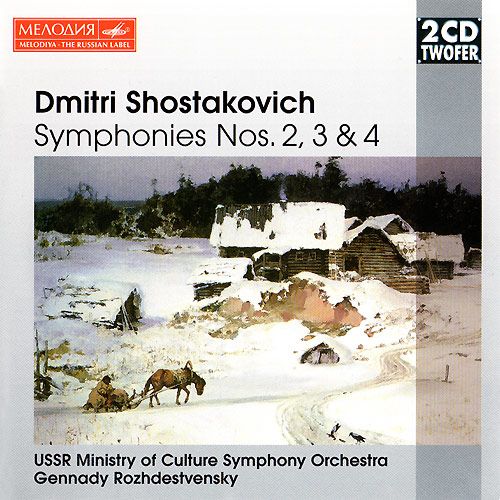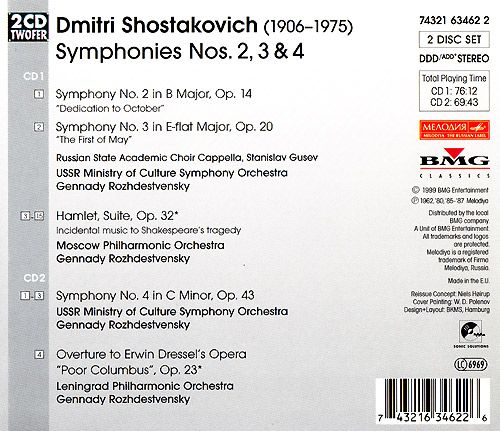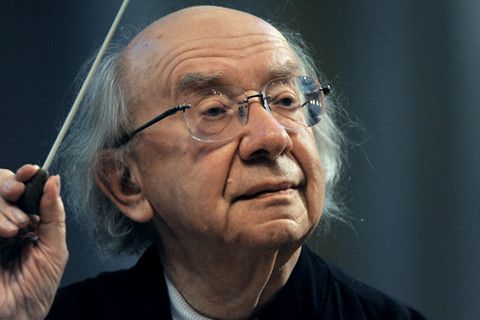wimpel69
11-28-2014, 02:33 PM
EAC-FLAC link below. This is my own rip. Complete artwork,
LOG and CUE files included. Do not share. Buy the original!
Please leave a "Like" or "Thank you" if you enjoyed this!
Composed for the tenth anniversary of the October Revolution, Shostakovich's Symphony No.2 (1927) is
something of an historical and musical artifact. Historically, it recalls a time when people still believed in the
Soviet system as the great hope for Russia and, indeed, for mankind; musically, it belongs to the period of
experimentation following World War I, when old rules of form and harmony were being tossed to the winds.
In the Symphony, in essence, Shostakovich simply tried out all sorts of musical ideas that interested him,
hoping that the result would all be of a piece. The work's very designation as a symphony -- it was originally
titled "To October: A Symphonic Dedication" -- appears to have been an afterthought, as though the
21-year-old composer wanted to relieve the pressure of having to follow up his spectacularly successful
teenage achievement, the Symphony No. 1 (1923-1925). The work is cast in a single 20-minute movement,
and opens in a dark, ominous miasma of atonality that leads into a violent martial section. A bizarre passage
for solo violin, clarinet, and bassoon introduces the work's most notorious segment, a fugue-like section
with no fewer than 13 subjects. Things quiet down a bit before a blast of a factory whistle -- not simulated,
but the actual "instrument" -- ushers in a chorus that literally sings the praises of the Revolution,
culminating at the end in a shout of "October and Lenin! The new age and Lenin! The commune and Lenin!"
Though embarrassingly jingoistic at times, and though a decidedly lesser accomplishment than Shostakovich's
later symphonies, the work contains moments of genuine excitement and drama and provides an intriguing
perspective on the evolution of one of the most-discussed composers of the twentieth century.
The Third Symphony bears many similarities to the 1927 Second: each is in one movement and uses
a chorus whose text celebrates Marxist or socialist ideas. Both works arose at a time when Soviet artists
were generally free to create art as they saw fit. Thus, Shostakovich was not coerced or persuaded to write
these "revolutionary" works, as he would later be with several other patriotic and ideological works. What
has been puzzling to many observers is that the promise offered by Shostakovich's Symphony No.1
seems largely to have been squandered in these two works on only intermittently successful experimentalism.
Apparently the composer viewed the Revolution as a signal to introduce new musical ideas, especially in the
area of form. The Third Symphony features a most unusual form: it is cast in one movement, marked
Allegretto, and has virtually no thematic development. Certain rhythmic patterns appear throughout to
offer some unity, but traditional thematic transformations and relationships are absent.
Shostakovich began composing his Symphony No.4 in September 1935 and put it aside in January
1936 while he went on tour with his cello sonata. On January 28, he read the unsigned editorial on the
front page of Pravda condemning him and two of his works and predicting he would come to a bad end if
he didn't literally change his tune. He finished the Fourth in May 1936, but withdrew the work while it was
still in rehearsal. The piece was premiered by Kiril Kondrashin in the U.S.S.R. in 1961 and in the West in
1962. Although Shostakovich had enough sense to withdraw the Fourth, he also had enough guts to finish
it as he started it: as a fusion of his own archly ironic modernism with the deep emotionalism and vast
scale of the Mahlerian Romantic symphony. The result is a gargantuan work for enormous orchestra in
three movements, lasting more than an hour in performance. The opening movement is a nearly half-
hour Allegretto poco moderato profligate in themes, bracing in orchestration, unfathomable in form,
and unrelentingly violent in expression. With an opening theme clearly based on the opening theme
of Mahler's Symphony No. 6, Shostakovich's Fourth goes its own way toward savage brutality
and more savage irony. Through volcanic eruptions and tectonic disruptions, the Allegretto pushes
and punches its way to a grinding conclusion. The central movement is a relatively brief Moderato
con moto that slithers and sneaks through a blasted landscape, trailing themes from the Scherzo
of Mahler's Second over ominous percussion rattling. The closing movement is as large as the opening
movement, but set in several contiguous sections: an opening funeral march Largo � la Mahler, a
fast and tough Allegro with a two-note ostinato, a sarcastically sentimental Viennese Waltz,
a grandiloquent peroration for the whole massive orchestra, and a quietly ticking coda haunted
by trumpet calls and a ghostly celesta.

Music Composed by
Dmitri Shostakovich
Played by the
USSR Ministry of Culture Symphony Orchestra
Moscow Philharmonic Orchestra
Leningrad Philharmonic Orchestra
With the
Russian State Academic Choir Cappella
Conducted by
Gennady Rozhdestvensky

"Gennady Rozhdestvensky, one of today�s greatest conductors, was born in Moscow in 1931.
He studied the piano with Lev Oborin and conducting with his father, Nikola� Anosov, at the
Moscow Conservatoire. At the age of 20, he was engaged at the Bolshoi Theatre where he
made his d�but conducting Tchaikovsky�s The Sleeping Beauty. His was to be a long term
relationship with the Bolshoi: he became their principal conductor between 1964 and 1970,
and in 2000 was appointed their General Music Director.
For many years, he also headed the Moscow Radio Orchestra and became the first Soviet
conductor, ever to be appointed principal conductor of various foreign orchestras: the BBC
Symphony Orchestra in London, the Vienna Symphony Orchestra, and the Stockholm Royal
Philharmonic Orchestra.
Gennady Rozhdestvensky also conducted an impressive number of performances at the
Royal Opera House Covent Garden (Boris Godunov and new productions of The Golden
Cockrell and The Nutcracker), at the Paris Opera (The Queen of Spades), at La Scala
(The Legend of Tsar Saltan by Rimsky-Korsakov and Der fliegende Holl�nder) among others.
He has also participated in dozens of world premieres of new or newly found works, some
of which were dedicated to him: works by composers including Prokofiev, Shostakovitch,
John Tavener, Alfred Schnittke, Rodion Shch�drine etc. In 2001, he gave the first
performance of the original version of Prokofiev�s opera The Gambler at the Bolshoi Theatre.
His prolific discography reveals his insatiable curiosity and makes him one of the most
recorded conductors of all time. His present catalogue features well over 400 records
comprising the astounding number of 786 different works.
Rozhdestvensky is the recipient of the French Legion of honour, of the Japanese Order
of the Rising Sun, and an Honorary Member of the Stockholm and British Academies.
In 2014, he received an honorary CBE for his services to music.
In 2011, he celebrated his 80th birthday together with the 60th anniversary of his
conducting debut with a special evening at the Bolshoi Theatre (New Stage) in which
he conducted scenes from The Sleeping Beauty, the Coronation scene from Boris
Godunov and Rachmaninov�s 2nd Symphony."

Download Link - https://mega.co.nz/#!GMgHmT7C!rTQcAbbMAWrDKbVWiGPIoaRV0FTg_Wc_UUEmnSt l-v0
Source: Melodiya-BMG CDs, 1999 (my rip!)
Format: FLAC(RAR), ADD/DDD Stereo, Level: -5
File Size: 681 MB (incl. artwork, booklet, log & cue)
Enjoy! Don't share! Buy the origina! Please leave a "Like" or "Thank you" if you enjoyed this! :)
LOG and CUE files included. Do not share. Buy the original!
Please leave a "Like" or "Thank you" if you enjoyed this!
Composed for the tenth anniversary of the October Revolution, Shostakovich's Symphony No.2 (1927) is
something of an historical and musical artifact. Historically, it recalls a time when people still believed in the
Soviet system as the great hope for Russia and, indeed, for mankind; musically, it belongs to the period of
experimentation following World War I, when old rules of form and harmony were being tossed to the winds.
In the Symphony, in essence, Shostakovich simply tried out all sorts of musical ideas that interested him,
hoping that the result would all be of a piece. The work's very designation as a symphony -- it was originally
titled "To October: A Symphonic Dedication" -- appears to have been an afterthought, as though the
21-year-old composer wanted to relieve the pressure of having to follow up his spectacularly successful
teenage achievement, the Symphony No. 1 (1923-1925). The work is cast in a single 20-minute movement,
and opens in a dark, ominous miasma of atonality that leads into a violent martial section. A bizarre passage
for solo violin, clarinet, and bassoon introduces the work's most notorious segment, a fugue-like section
with no fewer than 13 subjects. Things quiet down a bit before a blast of a factory whistle -- not simulated,
but the actual "instrument" -- ushers in a chorus that literally sings the praises of the Revolution,
culminating at the end in a shout of "October and Lenin! The new age and Lenin! The commune and Lenin!"
Though embarrassingly jingoistic at times, and though a decidedly lesser accomplishment than Shostakovich's
later symphonies, the work contains moments of genuine excitement and drama and provides an intriguing
perspective on the evolution of one of the most-discussed composers of the twentieth century.
The Third Symphony bears many similarities to the 1927 Second: each is in one movement and uses
a chorus whose text celebrates Marxist or socialist ideas. Both works arose at a time when Soviet artists
were generally free to create art as they saw fit. Thus, Shostakovich was not coerced or persuaded to write
these "revolutionary" works, as he would later be with several other patriotic and ideological works. What
has been puzzling to many observers is that the promise offered by Shostakovich's Symphony No.1
seems largely to have been squandered in these two works on only intermittently successful experimentalism.
Apparently the composer viewed the Revolution as a signal to introduce new musical ideas, especially in the
area of form. The Third Symphony features a most unusual form: it is cast in one movement, marked
Allegretto, and has virtually no thematic development. Certain rhythmic patterns appear throughout to
offer some unity, but traditional thematic transformations and relationships are absent.
Shostakovich began composing his Symphony No.4 in September 1935 and put it aside in January
1936 while he went on tour with his cello sonata. On January 28, he read the unsigned editorial on the
front page of Pravda condemning him and two of his works and predicting he would come to a bad end if
he didn't literally change his tune. He finished the Fourth in May 1936, but withdrew the work while it was
still in rehearsal. The piece was premiered by Kiril Kondrashin in the U.S.S.R. in 1961 and in the West in
1962. Although Shostakovich had enough sense to withdraw the Fourth, he also had enough guts to finish
it as he started it: as a fusion of his own archly ironic modernism with the deep emotionalism and vast
scale of the Mahlerian Romantic symphony. The result is a gargantuan work for enormous orchestra in
three movements, lasting more than an hour in performance. The opening movement is a nearly half-
hour Allegretto poco moderato profligate in themes, bracing in orchestration, unfathomable in form,
and unrelentingly violent in expression. With an opening theme clearly based on the opening theme
of Mahler's Symphony No. 6, Shostakovich's Fourth goes its own way toward savage brutality
and more savage irony. Through volcanic eruptions and tectonic disruptions, the Allegretto pushes
and punches its way to a grinding conclusion. The central movement is a relatively brief Moderato
con moto that slithers and sneaks through a blasted landscape, trailing themes from the Scherzo
of Mahler's Second over ominous percussion rattling. The closing movement is as large as the opening
movement, but set in several contiguous sections: an opening funeral march Largo � la Mahler, a
fast and tough Allegro with a two-note ostinato, a sarcastically sentimental Viennese Waltz,
a grandiloquent peroration for the whole massive orchestra, and a quietly ticking coda haunted
by trumpet calls and a ghostly celesta.

Music Composed by
Dmitri Shostakovich
Played by the
USSR Ministry of Culture Symphony Orchestra
Moscow Philharmonic Orchestra
Leningrad Philharmonic Orchestra
With the
Russian State Academic Choir Cappella
Conducted by
Gennady Rozhdestvensky

"Gennady Rozhdestvensky, one of today�s greatest conductors, was born in Moscow in 1931.
He studied the piano with Lev Oborin and conducting with his father, Nikola� Anosov, at the
Moscow Conservatoire. At the age of 20, he was engaged at the Bolshoi Theatre where he
made his d�but conducting Tchaikovsky�s The Sleeping Beauty. His was to be a long term
relationship with the Bolshoi: he became their principal conductor between 1964 and 1970,
and in 2000 was appointed their General Music Director.
For many years, he also headed the Moscow Radio Orchestra and became the first Soviet
conductor, ever to be appointed principal conductor of various foreign orchestras: the BBC
Symphony Orchestra in London, the Vienna Symphony Orchestra, and the Stockholm Royal
Philharmonic Orchestra.
Gennady Rozhdestvensky also conducted an impressive number of performances at the
Royal Opera House Covent Garden (Boris Godunov and new productions of The Golden
Cockrell and The Nutcracker), at the Paris Opera (The Queen of Spades), at La Scala
(The Legend of Tsar Saltan by Rimsky-Korsakov and Der fliegende Holl�nder) among others.
He has also participated in dozens of world premieres of new or newly found works, some
of which were dedicated to him: works by composers including Prokofiev, Shostakovitch,
John Tavener, Alfred Schnittke, Rodion Shch�drine etc. In 2001, he gave the first
performance of the original version of Prokofiev�s opera The Gambler at the Bolshoi Theatre.
His prolific discography reveals his insatiable curiosity and makes him one of the most
recorded conductors of all time. His present catalogue features well over 400 records
comprising the astounding number of 786 different works.
Rozhdestvensky is the recipient of the French Legion of honour, of the Japanese Order
of the Rising Sun, and an Honorary Member of the Stockholm and British Academies.
In 2014, he received an honorary CBE for his services to music.
In 2011, he celebrated his 80th birthday together with the 60th anniversary of his
conducting debut with a special evening at the Bolshoi Theatre (New Stage) in which
he conducted scenes from The Sleeping Beauty, the Coronation scene from Boris
Godunov and Rachmaninov�s 2nd Symphony."

Download Link - https://mega.co.nz/#!GMgHmT7C!rTQcAbbMAWrDKbVWiGPIoaRV0FTg_Wc_UUEmnSt l-v0
Source: Melodiya-BMG CDs, 1999 (my rip!)
Format: FLAC(RAR), ADD/DDD Stereo, Level: -5
File Size: 681 MB (incl. artwork, booklet, log & cue)
Enjoy! Don't share! Buy the origina! Please leave a "Like" or "Thank you" if you enjoyed this! :)